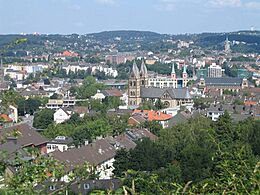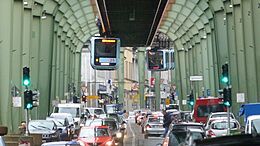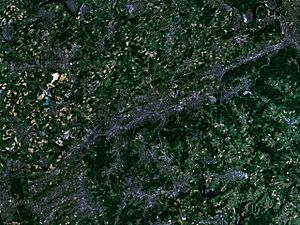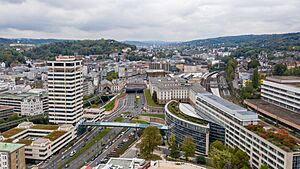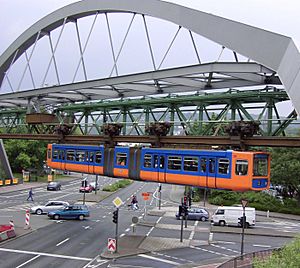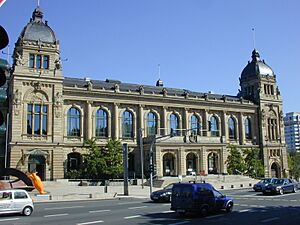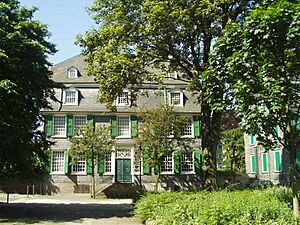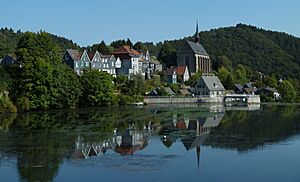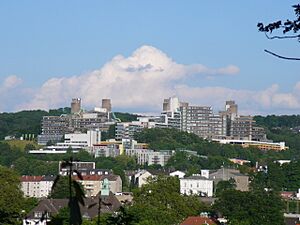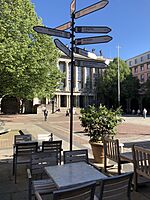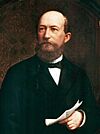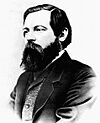Wuppertal facts for kids
Quick facts for kids
Wuppertal
|
|||
|---|---|---|---|
|
Clockwise from top: view over Wuppertal-Elberfeld, Wuppertal Suspension Railway running beneath Sonnborn Railway Bridge (Sonnborner Eisenbahnbrücke), St Lawrence's Basilica at dusk, the suspension railway running through the city, the suspension railway running above the Wupper, hilly cityscape at Friedrichstraße
|
|||
|
|||
| Country | Germany | ||
| State | North Rhine-Westphalia | ||
| Admin. region | Düsseldorf | ||
| District | Urban district | ||
| Elevation | 100-350 m (−1,048.3 ft) | ||
| Population
(2022-12-31)
|
|||
| • City | 358,876 | ||
| • Urban | 608,000 (Bergisches Dreieck) | ||
| • Metro | 11,300,000 (Rhein-Ruhr) | ||
| Time zone | CET/CEST (UTC+1/+2) | ||
| Postal codes |
42001-42399
|
||
| Dialling codes | 0202 | ||
| Vehicle registration | W | ||
| Website | wuppertal.de | ||
Wuppertal is a city in North Rhine-Westphalia, Germany. Its name means "Wupper Dale" because it's in the valley of the River Wupper. About 355,000 people live here. Wuppertal is the seventh-largest city in its state and 17th-largest in Germany.
The city was formed in 1929 by joining several towns like Elberfeld and Barmen. It was first called "Barmen-Elberfeld" but changed to Wuppertal in 1930. It's the main city of the Bergisches Land region.
Wuppertal is known for its unique Wuppertal Schwebebahn (a hanging railway), steep hills, and many green spaces. Two-thirds of the city is green, with woods and parks. You are always just a short walk from nature.
The Wupper Valley was one of Germany's first industrial areas. Factories here needed coal, which helped the nearby Ruhr region grow. Today, Wuppertal is still a big industrial center. It makes textiles, chemicals, cars, and more. Did you know that Aspirin was invented here by Bayer in 1897? The Vorwerk Kobold vacuum cleaner also comes from Wuppertal.
Contents
A Look at Wuppertal's Past
Wuppertal became one city in 1929. It joined together industrial towns like Barmen and Elberfeld. The new city was first called Barmen-Elberfeld. But in 1930, people voted to name it Wuppertal, meaning "Wupper Valley."
Wuppertal is a "linear city." This means it stretches out in a long line because of the steep hills along the Wupper river. Its highest point is the Lichtscheid hill, which is 351 meters (1,152 feet) above sea level. The main areas, Elberfeld and Barmen, have been connected since 1850.
During World War II, many buildings in Wuppertal were damaged. However, a lot of historic places were saved. For example:
- Ölberg is Germany's largest old working-class neighborhood. It's now a protected historic area.
- Brill has many large mansions built by business owners in the late 1800s.
Who Lives in Wuppertal?
Wuppertal has about 355,000 people today. The population grew a lot in 1929 when the towns merged. In the 1950s and 60s, more people moved here for jobs, including workers from Turkey, Greece, and Italy. The population reached its highest point in 1963 with about 423,000 people. After that, the number slowly went down as some industries changed.
Many people from different countries live in Wuppertal. Here are some of the largest groups of foreign residents as of 2022:
| From country | Number of residents |
|---|---|
| 11,575 | |
| 7,415 | |
| 6,870 | |
| 6,130 | |
| 5,870 | |
| 5,387 | |
| 2,835 | |
| 2,463 | |
| 2,197 | |
| 1,724 | |
| 1,593 | |
| 1,439 | |
| 1,354 | |
| 1,273 | |
| 1,228 | |
| 1,147 |
Must-See Places in Wuppertal
Wuppertal has over 4,500 buildings that are national monuments. They show different styles like Neoclassicism and Art Nouveau. CNN even suggested Wuppertal as a top place to visit in 2020!
Here are some main sights:
- The Schwebebahn or floating tram: This unique hanging monorail opened in 1901. It runs 8 meters (26 feet) above streets and 12 meters (39 feet) above the Wupper River. You can even take a special tour in the historic Kaiserwagen tram.
- Wuppertal Opera (Opernhaus Wuppertal).
- Concert Hall Stadthalle: This beautiful building has amazing sound. It's home to the Wuppertal Symphony Orchestra.
- Wuppertal Dance Theatre: This world-famous dance company was started by choreographer Pina Bausch.
- Engels-Haus: This 18th-century house shows the life of Friedrich Engels, who helped create modern Communism.
- Wuppertal Zoo: A large and lovely zoo.
- Botanischer Garten Wuppertal: A city botanical garden.
- Arboretum Burgholz: A big tree collection.
- Von der Heydt Museum: An important art gallery with works from the 17th century to today.
- Skulpturenpark Waldfrieden: A sculpture park with an exhibition hall, started by sculptor Tony Cragg.
Wuppertal in Movies and Books
Wuppertal has been featured in several movies and books:
- The 1974 movie Alice in the Cities by Wim Wenders visits Wuppertal.
- Part of the comic book Yoko Tsuno series, Le Feu de Wotan (1984), takes place in Wuppertal and features its Schwebebahn.
- The play Die Wupper by Else Lasker-Schüler is set in Elberfeld.
- The 2000 movie The Princess and the Warrior was filmed in Wuppertal.
- The 2011 movie Pina shows many dance scenes in and around Wuppertal, often using the elevated tram as a background.
Sports in Wuppertal
Wuppertal has a lively sports scene with popular teams in different sports.
Football Fun
The most popular football club is Wuppertaler SV. They play their home games at the Stadion am Zoo. The club has a long history, even playing in Germany's top league, the Bundesliga, in the 1970s. In their first Bundesliga season (1972), they finished in a great fourth place!
Another football club is Cronenberger SC. They once reached the final of the German amateur football championship in 1952.
Handball Action
In handball, the most successful team is Bergischer HC. They play in the top German league, the Handball-Bundesliga. This team represents the whole Bergisches Land region.
Volleyball Victories
SV Bayer Wuppertal was a leading men's volleyball team in the 1990s and 2000s. They won the German championship twice and the German Cup once. They even came in second in a European Cup in 1996!
Basketball Success
The women's basketball team of Barmer TV was very successful. They won the German championship 11 times and the German Cup 12 times! From 1993 to 2002, they won both titles for ten years in a row. In 1996, they won the European Cup, being the first German team to do so.
Roller Hockey Wins
In roller hockey, RSC Cronenberg is one of Germany's best teams. Both their men's and women's teams have won many German championships and cups. Wuppertal has also hosted several international roller hockey tournaments.
Learning in Wuppertal
Wuppertal has several places for higher education:
- University of Wuppertal (Bergische Universität Wuppertal)
- FOM University of Applied Sciences
- Cologne University of Music, section Wuppertal
- College of Theology, Wuppertal/Bethel (Theologische Zentrum Wuppertal)
There's also a special place called the Junior Uni. It's a private program that teaches science to young people aged 4 to 18 outside of school.
Getting Around Wuppertal
Wuppertal has good train connections. Its main train station, Wuppertal Hauptbahnhof, is in the Elberfeld area. You can catch long-distance trains here. Other stations like Oberbarmen and Barmen also serve the city.
The most famous way to get around is the Wuppertal Suspension Railway, the unique hanging monorail. It has been running since 1901! New train cars were added in 2016.
A funny story about the Schwebebahn happened in 1950. A young elephant named Tuffi was put on the monorail for a circus promotion. Tuffi got scared and fell 12 meters (40 feet) into the river below! Luckily, she only had minor injuries and lived until 1989.
Wuppertal's Twin Cities
Wuppertal has "twin city" friendships with many places around the world:
 South Tyneside, England, United Kingdom (1951)
South Tyneside, England, United Kingdom (1951) Saint-Étienne, France (1960)
Saint-Étienne, France (1960) Tempelhof-Schöneberg (Berlin), Germany (1964)
Tempelhof-Schöneberg (Berlin), Germany (1964) Beersheba, Israel (1977)
Beersheba, Israel (1977) Košice, Slovakia (1980)
Košice, Slovakia (1980) Schwerin, Germany (1987)
Schwerin, Germany (1987) Matagalpa, Nicaragua (1987)
Matagalpa, Nicaragua (1987) Legnica, Poland (1993)
Legnica, Poland (1993)
A Sister Suspension Railway
The Wuppertal Suspension Railway also has a "sister" railway! It's twinned with the Shonan Monorail in Japan since 2018. Both are unique suspended railways.
Famous People from Wuppertal
Many well-known people were born or lived in Wuppertal:
- Pina Bausch (1940–2009), a famous choreographer.
- Friedrich Bayer (1825–1880), who started the Bayer company.
- Friedrich Engels (1820–1895), a philosopher and writer.
- Felix Hoffmann (1868–1946), the scientist who created aspirin.
- Else Lasker-Schüler (1869–1945), an expressionist poet.
- Johannes Rau (1931–2006), a former President of Germany.
- Alice Schwarzer (born 1942), a leader in German feminism.
- Tom Tykwer (born 1965), a movie director.
Images for kids
See also
 In Spanish: Wuppertal para niños
In Spanish: Wuppertal para niños


